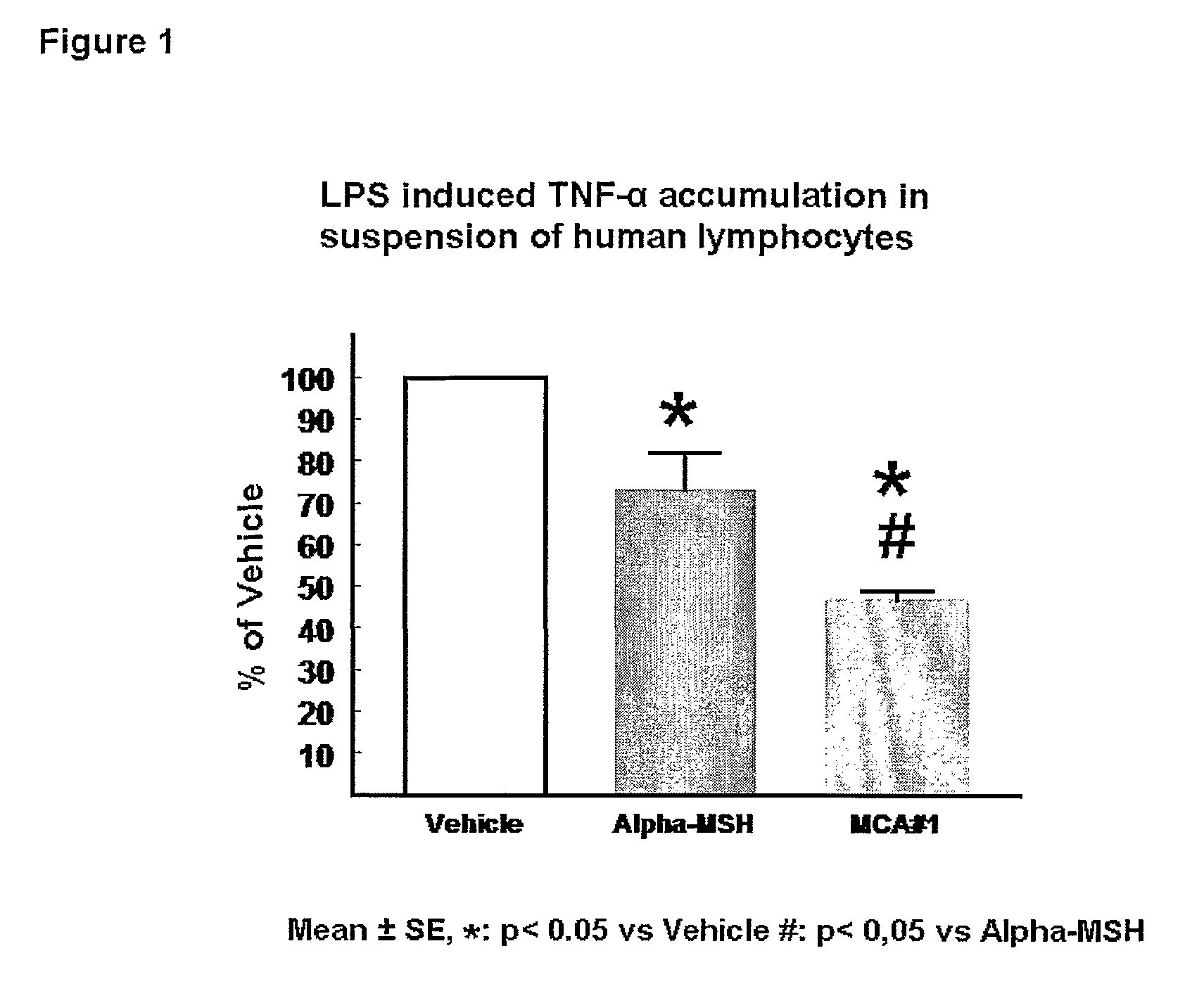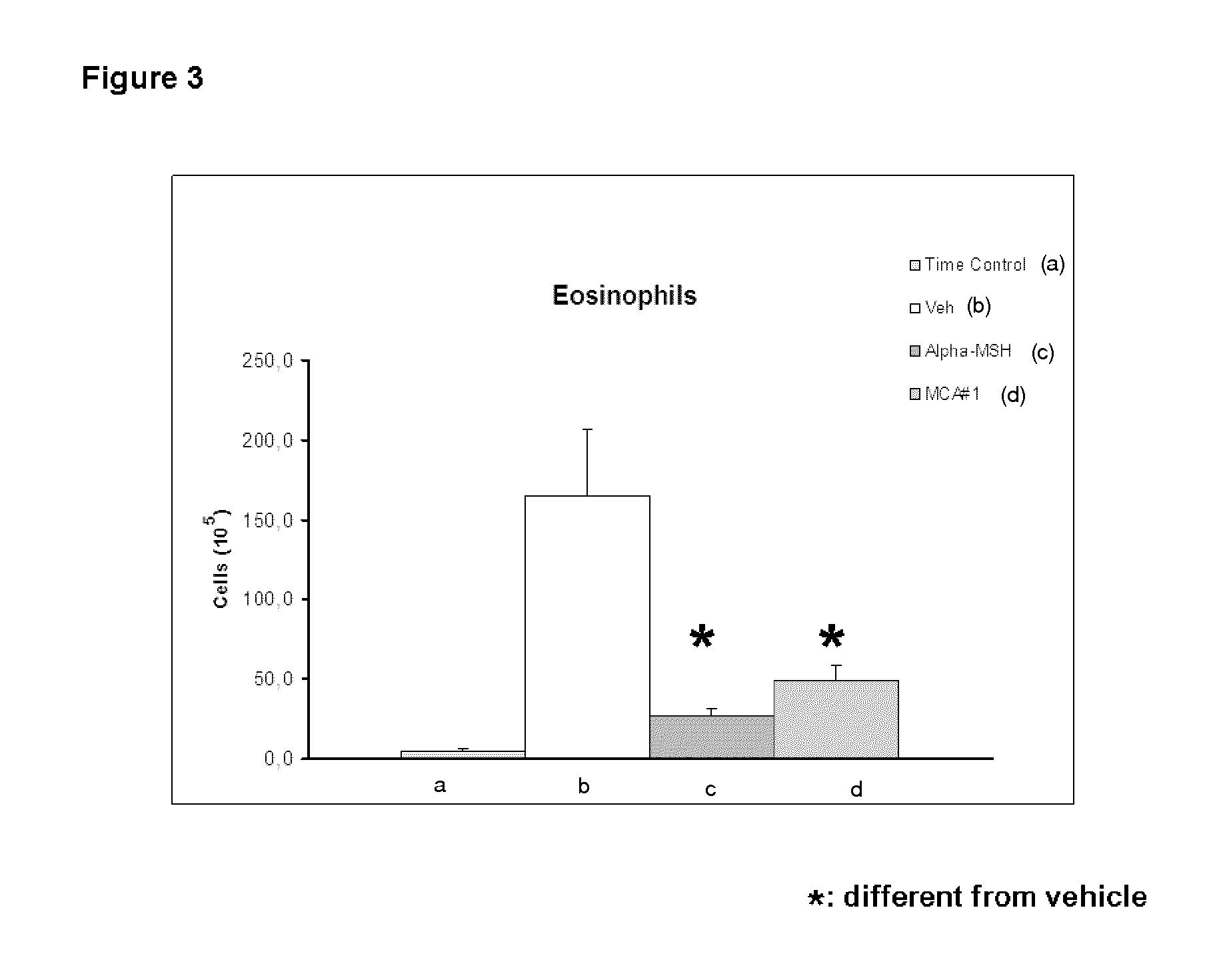Therapeutically active alpha MSH analogues
a technology of melanocytestimulating hormone and analogues, which is applied in the field of peptide analogues of melanocytestimulating hormone, can solve the problems of peptides that are usually susceptible to degradation, peptides that are still stable towards enzymatic degradation, and peptides that are usually within the range of minutes. , to achieve the effect of increasing the maximal efficacy of peptides, increasing anti-inflammatory effects, and increasing the capacity o
- Summary
- Abstract
- Description
- Claims
- Application Information
AI Technical Summary
Benefits of technology
Problems solved by technology
Method used
Image
Examples
example 1
[0333]Test compound is α-MSH analogue #1:[0334]Ac-Lys-Lys-Lys-Lys-Lys-Lys-Ser-Tyr-Ser-Met-Glu-His-Phe-Arg-Trp-Gly-Lys-Pro-Val-NH2 (SEQ ID NO.1 *acetylated in the N-terminal and amidated in the C-terminal)
[0335]The compound is tested in experimental setup 1-7.
Inhibition of LPS Induced TNF-α Production by Human Leucocytes In Vitro
[0336]Both a-MSH and the α-MSH analogue #1 (SEQ ID NO.1*) dose dependently reduce LPS induced TNF-a accumulation in the human leucocyte suspension. Surprisingly, the inhibitory effect of the α-MSH analogue #1 (SEQ ID NO.1*) is markedly more pronounced that the anti-inflammatory effect of the native peptide a-MSH. a-MSH inhibits the TNF-a accumulation to 73±9% of the maximal response (LPS-Vehicle). In contrast to this the a-MSH analogue #1 (SEQ ID NO.1*) is able to reduce the TNF-a accumulation to 47±2% of vehicle (P<0.01 vs aMSH) (see FIG. 1).
Inhibition of LPS Induced TNF-α Production in Rats In Vivo
[0337]Both a-MSH and the a-MSH analogue #1 (SEQ ID NO.1*) re...
example 2
[0343]Test compound is a-MSH analogue #2:[0344]Ac-Lys-Lys-Lys-Lys-Lys-Lys-Ser-Tyr-Ser-Nle-Glu-His-(D-Phe)-Arg-Trp-Gly-Lys-Pro-Val-NH2 (SEQ. NO. 5 *acetylated in the N-terminal and amidated in the C-terminal)
[0345]The a-MSH analogue #2 (SEQ. NO. 5) differs from a-MSH analogue #1 (SEQ ID NO.1*) by substitution of Met with Nle at position 10 and by stereochemical substitution of Phe with (D-Phe) at position 13.
[0346]The compound is tested in experimental setup 1-3 and 5-7.
Inhibition of LPS Induced TNF-α Production by Human Leucocytes In Vitro
[0347]Both a-MSH and the a-MSH analogue #2 (SEQ. NO. 5*) dose dependently reduce LPS induced TNF-a accumulation in the human leucocyte suspension. Surprisingly, the inhibitory effect of the a-MSH analogue #2 (SEQ. NO. 5*) is markedly more pronounced than the anti-inflammatory effect of the native peptide a-MSH. a-MSH inhibits the TNF-a accumulation to 73±9% of the maximal response (LPS-Vehicle). In contrast to this the a-MSH analogue #2 (SEQ. NO. 5...
example 3
[0353]Test compound is a-MSH analogue #3:[0354]Ac-Lys-Lys-Lys-Lys-Lys-Lys-Ser-Tyr-Ser-Nle-Glu-His-D-Nal-Arg-Trp-Gly-Lys-Pro-Val-NH2 (SEQ ID NO.9 *acetylated in the N-terminal and amidated in the C-terminal)
[0355]The a-MSH analogue #3 (SEQ. NO. 9) differs from a-MSH analogue #1 (SEQ ID NO.1*) by substitution of Met wilt Nle at position 10 and by substitution of Phe with D-Nal at position 13.
[0356]The compound is tested in experimental setup 1, 2 and 5.
Inhibition of LPS Induced TNF-α Production by Human Leucocytes In Vitro
[0357]Both a-MSH and the a-MSH analogue #3 (SEQ ID NO.9*) dose dependently reduce LPS induced TNF-a accumulation in the human leucocyte suspension. Surprisingly, the inhibitory effect of the a-MSH analogue #3 (SEQ ID NO.9*) is markedly more pronounced than the anti-inflammatory effect of the native peptide a-MSH. a-MSH inhibits the TNF-a accumulation to 73±9% of the maximal response (LPS-Vehicle). In contrast to this the a-MSH analogue #3 (SEQ ID NO.9*) is able to re...
PUM
| Property | Measurement | Unit |
|---|---|---|
| weight | aaaaa | aaaaa |
| weight | aaaaa | aaaaa |
| body weight | aaaaa | aaaaa |
Abstract
Description
Claims
Application Information
 Login to View More
Login to View More - R&D
- Intellectual Property
- Life Sciences
- Materials
- Tech Scout
- Unparalleled Data Quality
- Higher Quality Content
- 60% Fewer Hallucinations
Browse by: Latest US Patents, China's latest patents, Technical Efficacy Thesaurus, Application Domain, Technology Topic, Popular Technical Reports.
© 2025 PatSnap. All rights reserved.Legal|Privacy policy|Modern Slavery Act Transparency Statement|Sitemap|About US| Contact US: help@patsnap.com



